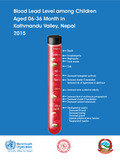Please use this identifier to cite or link to this item:
https://hdl.handle.net/20.500.14356/765| Title: | Blood Lead level among children aged 06-36 month in Kathmandu Valley, Nepal 2015 |
| Authors: | Dhimal, Meghnath Aryal, Krishna Kumar Dhimal, Bimala Ansari, Imran Sharma, Arun Kumar |
| Citation: | Dhimal M, Aryal KK, Dhimal B, Ansari I, Sharma AK, Shrestha D, Raya GB, Dhakal P, Joshi HD, Puri S, Karki KB. Blood Lead Level among Children Aged 06-36 Month in Kathmandu Valley, 2015. Kathmandu, Nepal: Nepal Health Research Council, 2016. |
| Issue Date: | 2016 |
| Publisher: | Nepal Health Research Council |
| Keywords: | Lead exposure Poisoning Blood Lead level Nepal |
| Abstract: | Introduction: Lead is a highly toxic metal which has contaminated our environment and creates health problems. Even a very small intake of lead is a serious and sometimes creates a fatal condition. Young children are at the greatest risk of health problems related to lead exposure. This study aims to assess blood lead levels (BLLs) among the children 06-36 months residing in Kathmandu Valley, Nepal. Materials and methods: This was a hospital based cross -sectional study. A total of 312 children of 06-36 months old visiting paediatric unit of the TUTH, Patan Hospital and Siddhi Memorial Hospital of Kathmandu valley were enrolled in the study. Anodic Stripping Voltammetry (ASV) portable instrument was used to determine the blood lead level in children. Written informed consent were taken from parents and required data were collected using the structured questionnaire from the parents. Data were analyzed using the SPSS version 16. Results: Out of the total 312 children enrolled in the study, 64.4% had the BLL exceeding the cut off points of centers for diseases control and prevention (CDC), (=5µg/dl), while 35.6% had less than 5µg/dl of BLLs. A significant association was found between BLLs and the enamel paints painted in different parts of the house like walls, windows and doors (p=0.001). Further, multivariate analysis showed that BLLs was 4.5 times higher in children playing with dirt and dust (p=0.006) and children belonging to the ethnic group such as Dalits, disadvantaged Janajatis and Non-Dalits Terai caste groups, religious minorities and relatively advantaged janajatis had found significantly higher BLL compared to upper caste group(p=0.02). Keywords: Lead exposure, poisoning, blood lead level, Nepal |
| URI: | http://103.69.126.140:8080/handle/20.500.14356/765 |
| Appears in Collections: | NHRC Research Report |
Files in This Item:
| File | Description | Size | Format | |
|---|---|---|---|---|
| Blood Lead Level among Children Aged 06-36 Month in Kathmandu Valley Nepal 2015.pdf | View Full Text Report. | 2.22 MB | Adobe PDF |  View/Open |
Items in DSpace are protected by copyright, with all rights reserved, unless otherwise indicated.
